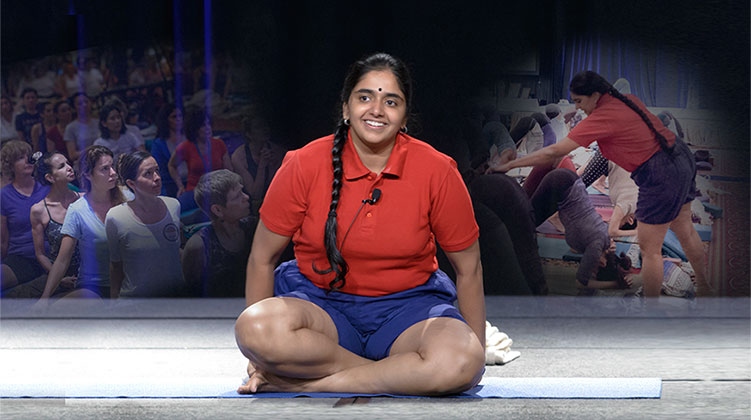
By Ainhoa Acosta
Ainhoa has a Masters degree in Audio Production and has worked as a Promo Producer and Creative Executive for the World Service and BBC News. She teaches the children’s yoga class, a beginners’ class and an introductory course at Maida Vale.
She currently teaches a studio class for Beginners on Mondays at 18.15 BST
When going to a yoga class for the very first time, some students may be surprised that we start the class chanting ‘Om’ three times. Some feel at ease straight away, while others might feel self-conscious or wonder why we chant a word in Sanskrit without knowing what it means. Sometimes that first Om is strained, not harmonious, only to become a smooth and pleasant sound by the third repetition. Often there is the question of whether it has a religious connotation. Let us look at this more closely.
The philosophy of Om
In yoga philosophy, Om is considered a sacred syllable. “Like the Latin word ‘Omne’, the Sanskrit word ‘Om’ means ‘all’ and conveys concepts of ‘Omniscience’, ‘Omnipresence’ and ‘Omnipotence’” (BKS Iyengar, ‘Light on Yoga’, p. 445). Om is a sacred ‘mantra’. It is considered a universal sound, the seed of all words without reference to any specific religion or god. According to the Big Bang theory, Om is the cosmic sound that initiated the creation of the universe. This sacred syllable is not just one sound, it is actually three. The ‘Pranava’ (power) mantra comprises three syllables: ‘a’, ‘u’, ’m’, indicating the continuity of past, present and future. The Aum sound encompasses the masculine, feminine and neutral principles. It also addresses speech (‘vak’), mind (‘manas’) and breath (‘prana’) and alludes to the famous trinity of Indian cosmology, the creator (Brahma), the maintainer (Vishnu) and the destroyer (Shiva). By chanting Aum at the beginning of class or practice, the divinity within each of us is addressed, invited and called in.
When we perceive the sound of our own voice, we notice our own presence. Through sound, an invisible yet physical expression, we are closer to perceiving our true self and our true nature. We are never separate from sound; even if we can’t speak or hear we feel its physical vibration throughout our bodies. At the point of chanting Aum, there is no thought, no separation. Regular practice enhances a sense of centeredness. It is also said that while chanting Aum, the syllable is the target and our attention becomes focused on one point (‘Ekagrata’). Like holding the bow and using the Self as the arrow, chanting gives us a clear sense of direction and focus. It is the beginning of the inward journey and thus the beginning of the class and of practice.
The science behind Aum The effects of chanting Aum at the beginning of each class go beyond the philosophical realm. It is well recognised that sound is a powerful tool for healing and can have profound effects. The ancient yogis knew and practised many methods that are now becoming accepted by the scientific community. One of these is the chanting of mantras. Mantras are syllables that exert an influence or effect through sound vibrations that resonate on specific parts of the body. Different syllables vibrate at different sound frequencies and so they will resonate with certain organs and parts of the body. The human hearing range is 20Hz to 20KHz. Aum vibrates at 432 Hz, which is quite low within our hearing range. This means that the sound wave is longer and its frequency of vibration slower than a high-pitch sound at, let’s say, 15KHz. The physical result of this is that these sound waves will affect bigger surface areas. At a physical level, the Aum syllable addresses the whole of the human sound instrument: we open the mouth (‘a’), move the lips closer to each other (‘u’) and then close the mouth (‘m’). This activates the larynx fully. ‘A’ resonates in the stomach and chest, ‘u’ in the throat and chest and ‘m’ in the nasal cavity, skull and brain. By chanting Aum we move the energy from the abdomen up to the brain. Those of us who chant Aum daily before our practice, feel how it helps us to calm our mind and clear our thoughts.

Specific scientific research
Modern technology, such as sound spectrum analysis and brain imaging technology, has made it possible to analyse the structure and quality of soundwaves produced by chanting, as well as the physiological responses induced by the repetition of the Aum sound. Separate research studies were carried out on volunteers who have never chanted before. The recordings and the sound waves were analysed before and after some weeks of chanting Aum on a regular basis. The soundwaves of those who had never done any chanting showed irregular patterns, indicative of unsteadiness of breath and more restless minds. By contrast, the soundwaves recorded after a period of regular chanting were smooth, evenly spaced and harmonic, a clear indication of more regular breathing. There was an increased connection between the breath and mind, which resulted in an improved sense of calmness.1
In another experiment, functional Magnetic Resonance Imaging scans (f-MRI scans) were used to analyse the brain and measure the response of the nervous system during and after the Aum mantra chanting. It’s findings showed that the regular chanting of Aum can be effective in the treatment of depression & epilepsy.2 Other studies have revealed that regular Aum chanting can help lower high blood pressure.3 Other effects of chanting Aum regularly are improved concentration and a reduction in stress levels.4 Modern technology and science confirm what ancient yogis knew about the healing power of Aum. So much in just one sound.
References OM sound from NASA:
The Power of OM: https://www.bbc.co.uk/programmes/b012mzsp
Sound file of what the big bang AUM might have sounded like: http://faculty.washington.edu/jcramer/BigBang/WMAP_2003/BBSnd20.wav
The sound of the big bang: http://faculty.washington.edu/jcramer/BBSound_2003.html
1 Gurjar, A. A., and Ladhake, S. A., ‘Time-Frequency Analysis of Chanting Sanskrit Divine Sound “OM” Mantra’, IJCSNS International Journal of Computer Science and Network Security, Vol. 8, August 2008, pp. 170-175; http://paper.ijcsns.org/07_book/200808/20080825.pdf 2 Kalyani, B. G., Venkatasubramanian, G., Arasappa, R., Rao, N. P., Kalmady, S. V., Behere, R. V., Rao, H., Vasudev, M. K., and Gangadhar, B. N., ‘Neurohemodynamic correlates of ‘OM’ chanting: A pilot functional magnetic resonance imaging study’, International Journal of Yoga, January 2011, 4 (1), pp. 3-6; https://www.ncbi.nlm.nih.gov/pubmed/21654968 3 http://www.dailymail.co.uk/health/article-1258234/Chants-fine-thing-It-sound-daft-doctors-believe-meditation-really-lower-blood-pressure.html 4 Gurjar A. A., Ladhake, S. A., Thakare, A. P., ‘Analysis Of Acoustic of “OM” Chant To Study It’s Effect on Nervous System’, IJCSNS International Journal of Computer Science and Network Security, Vol. 9 No.1, January 2009, pp. 363-367, p. 366; http://paper.ijcsns.org/07_book/200901/20090151.pdf
This article was first published in Dipika, the journal of Iyengar Yoga London, Issue No.52, July 2020. If you would like to republish this article, please ask the editor for permission. office@iyengaryogalondon.co.uk
Blog categories
Become a member
Join our community to get reduced class prices, early booking for events and workshops plus access to the studio for self practice.
Recent news and articles
Iyengar Yoga Home Practice Videos with Raya Uma Datta
27 March 2025|
B.K.S. Iyengar’s visits to Ann Arbor, Michigan
20 March 2025|
Origins of the Modern Yoga Mat
24 October 2024|












